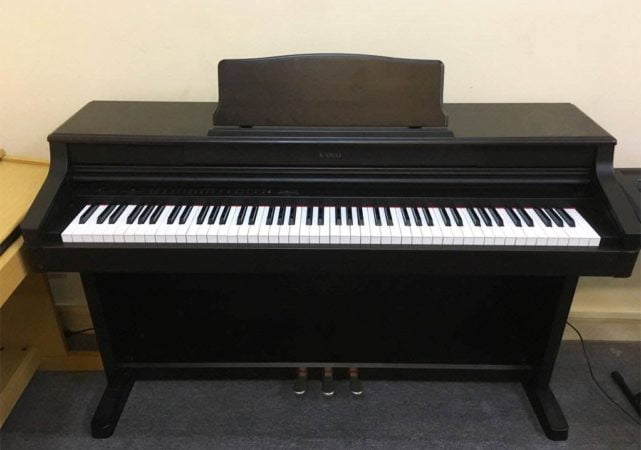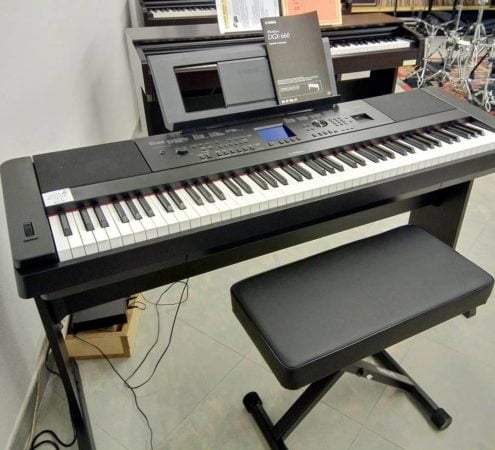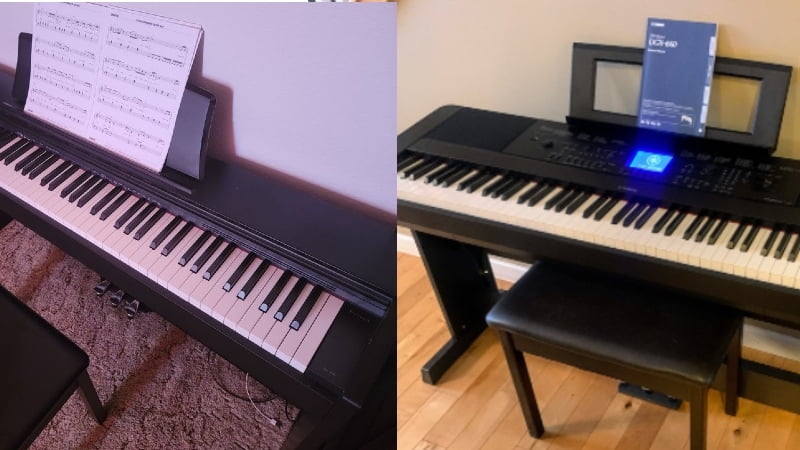In this Casio PX-770 vs Yamaha DGX-660 review, we’ll discuss why it might be better for you to invest in the portable Yamaha model, especially if you’re a beginner.
The portable vs console digital piano debate is one that is ever-present in the piano community. And in this Casio PX-770 vs Yamaha DGX-660 comparison, the debate rings on.
In the world of console digital pianos, the Casio PX-770 is one of my favorites. It’s affordable, comes with a bunch of different features, and comes with a rich sound library that beats out many others in its price range.
So, if you’re looking for an affordable top-tier console digital piano, you can’t do much better than the Casio PX-770.
However, to my surprise, it was no match for the versatility of the Yamaha DGX-660, which is portable, has an incredibly vast sound library, and features premium tones.
While it may be the more expensive option, if you’re a beginner looking for versatility, the Yamaha DGX-660 might just be a better investment than the Casio PX-770.
Casio PX-770 vs Yamaha DGX-660: Comparison Chart




Last update on 2025-12-15 / Affiliate links / Images from Amazon Product Advertising API
Casio PX-770 vs Yamaha DGX-660: The Features
To find out the winner between these two pianos, I decided to compare the features head to head. And while the Casio PX-770 was close behind in each of these comparisons, the final score was 2-1 in favor of the Yamaha DGX-660.
And in this section, we’ll be diving into the fine details on how the Yamaha DGX-660 won out over the Casio PX-770.

Tone
The winner: Yamaha DGX-660
Since the Yamaha DGX-660 is the more expensive model, I expected it to have a wider sound library. And while that was true, I was surprised at how well the cheaper Casio PX-770 held up in terms of sound quality.
And in the end, if it weren’t for the versatile sound library of the DGX-660, these two pianos would have been tied in terms of tone.
+Tone Generation
The Casio PX-770 features the AiR Sound Source. If you’re looking for a good digital piano that produces very realistic piano tones, any Casio model with the AiR Sound Source is a good investment.
The AiR Sound Source uses AI technology to ensure the sound waves travel through the air the same way acoustic piano sound waves travel. That way, you end up getting a very realistic sound that can rival many other models in its price range. In fact, the tone quality on the Casio PX-770, it’s comparable to the sound on the DGX-660, which is far more expensive.
With that said, the DGX-660’s premium price also comes with a premium sound engine. This piano uses the Pure CF Sound Engine, which takes its tones from the high-quality Yamaha CF concert grand pianos.
So, as expected, the DGX-660 produces a wide array of rich tones that sound very close to an acoustic piano.
+Sound Library
While these two models were very close in terms of tone generation and sound quality, the Casio PX-770 could not compare with the sound library of the DGX-660.
The Casio PX-770 comes with 19 different voices. Now, for a digital piano, this is actually a fair amount. With this model, you can experiment with a variety of different organ, synth, bass, strings, and acoustic and electric piano sounds. This is more than enough for a beginner, and is one of the reasons this console digital piano is highly recommended for any beginner or even novice piano player.
With that said, you get hundreds of different voices on the DGX-660. With the DGX-660, you get 155 different premium voices to choose from. These are in the same categories as the Casio PX-770, the only difference is that you have more choices in each category.
On top of that, the DGX-660 features a wide array of different MIDI voices, drums, and SFX. While these sounds won’t be as high-quality as the original 151 tones on the piano, most pianists will still find some use for these tones.
Feel

The winner: Casio PX-770
In terms of feel, I was actually surprised that the Casio PX-770 offered a more realistic and premium feel than the Yamaha DGX-660. While the hammer action on these two models were the same, the main difference was in the key texture. And since the Casio PX-770’s keys feature a textured coating, it offered a slightly more realistic feel than the DGX-660.
+Hammer Action
The Casio PX-770 features regular scaled hammer action while the Yamaha DGX-660 features the Graded Hammer Standard (GHS). Both of these systems accomplish the same thing. On either piano, the left side will be significantly heavier than the right side, which is the same way other digital pianos are set up.
The difference in hammer action between these two pianos is very minimal. In fact, when testing them out myself, I could barely tell the difference between the two.
Both of these pianos offer very realistic hammer action. However, since the Casio PX-770 is the cheaper option by far, you might be better off just getting the Casio if you’re looking for a realistic feel. That way, you also get to save money.
+Key Texture
While the hammer action of both pianos was fairly similar, the main difference was in the key texture. Both models have plastic keys, but the Casio PX-770’s keys are coated.
This coating is designed to emulate the feel of real wooden keys. That way, your fingers won’t slip while playing and you get a more realistic overall playing experience. Most pianos in this price range only feature glossy piano keys, which is why the Casio PX-770 is one of the best in its price range.
The Yamaha DGX-660 doesn’t feature any coating. So, the white keys on this piano are completely glossy. However, the black keys are matted, which does a pretty good job at reducing slipping.
But at the end of the day, since the Casio PX-770 features a coating on all the keys and not just the black ones, it offered a more realistic overall feel.
Piano Features

The winner: Yamaha DGX-660
Since the Yamaha DGX-660 is portable and designed to be a workhorse instrument, it comes with more piano features and effects. While these are just add-ons and not exactly necessary, these features were the main reason I found the DGX-660 to be the better option over the Casio PX-770.
+Playing Modes
The Yamaha DGX-660 split, dual, and lesson mode. Luckily, these features are also available on the Casio PX-770, which shows how the Casio PX-770 regularly out performs other options in its price range.
With these modes, you can split the piano and load them with different voices on each side. With dual mode, you can blend two different voices to get a unique tone. And with lesson mode, you can split the instrument into two separate mini keyboards with the same tuning, which is ideal for people going to piano lessons.
Both of these pianos also feature recording mode. But while the Casio PX-770 only features 2-track recording, the Yamaha DGX-660 features up to six different tracks. While most beginners won’t need 6-track recording, it’s still a nice feature to have that adds another layer of versatility.
+Effects
In terms of effects, the Casio PX-770 didn’t stand a chance against the more premium Yamaha DGX-660. With that said, the Casio PX-770 features chorus, reverb, and brilliance effects. This gives you a fair amount of room to customize and produce your own unique tones, and most pianos in the same price range can’t match that versatility.
However, since the Yamaha DGX-660 is in a completely different price range, it’s able to offer even more effects. With the DGX-660, you get reverb, chorus, Master EQ, DSP, and even IAC. These are way more than the Casio PX-770 and all of these offer a great way to customize your own unique tone.
If you’re a beginner you won’t exactly need these effects, so if you’re looking to save money the Casio PX-770 will serve you just fine. But if you’re an advanced player who’s very particular about their piano tones, the extra versatility of the DGX-660 might be worth the investment.
Casio PX-770 vs Yamaha DGX-660: The Similarities
These are two very different pianos, one is a portable option (the DGX-660) while the other is designed to stay in one place. So, they won’t have as many similarities as other options on the market. On top of that, they are in very different price ranges, which is why they come with different sets of features.
However, they do feature a similar hammer action system. That way, you get a very realistic feel when playing the pianos. Additionally, they also come with the same playing modes.
It was a pretty surprising thing for me to learn that both pianos had the same playing modes, largely because the Yamaha DGX-660 is much more expensive than the Casio PX-779. This is simply a testament to the Casio PX-770’s ability to compete with models out of its price range.
And while it couldn’t win against the Yamaha DGX-660, it held its own in each and every category. So, if you’re looking to invest in a versatile piano fit for advanced musicians, the DGX-660 is the one for you.
But if you’re a beginner looking for a great console piano without busting the bank, you might be better off with the cheaper Casio PX-770.
Quick Rundown of the Casio PX-770
- IMMERSIVE GRAND PIANO SOUND – Award-winning AiR Sound Source with stereo grand piano, damper resonance, and 19 tones for rich, expressive performances.
- REALISTIC TOUCH & FEEL – 88-key Tri-Sensor II Hammer Action with ebony/ivory-feel keys, adjustable touch sensitivity, and hammer response.
- CLEAR, POWERFUL AUDIO – Built-in stereo speaker system delivers detailed, balanced sound across the full range.
- BUILT FOR LEARNING – Duet Mode, dual headphone jacks, 60 built-in songs, MIDI recorder, and Concert Play orchestral backing tracks.
- SLIM, STYLISH DESIGN – Elegant cabinet with sliding key cover fits any décor. USB-MIDI port connects easily to Mac, PC, iOS, or Android—no drivers needed.
Last update on 2025-12-15 / Affiliate links / Images from Amazon Product Advertising API
Quick Rundown of the Yamaha DGX-660
- The Pure CF Sound Engine faithfully reproduces the tone of a meticulously sampled and highly acclaimed Yamaha concert grand piano
- GHS weighted action is heavier in the low register and lighter in the high, just like an acoustic piano
- Score display puts music notation of MIDI songs on the screen, helping you play your favorites by following the bouncing ball
- The Piano room lets you choose from a variety of pianos and acoustic settings to create your own personal piano environment
- The 6 track recorder allows you to capture your performances and song ideas, then add additional layers to spice up your pieces
Last update on 2025-12-15 / Affiliate links / Images from Amazon Product Advertising API
Product Videos
Related Articles to Casio Px 770
- Casio PX-770 vs Korg B2SP: A Battle of Budget Console Digital Pianos?
- Casio PX-770 vs Kawai KDP-110: The Best Console Digital Pianos on a Budget?
- Casio PX-770 vs Kawai ES-110: Should You Get A Portable or Console Digital Piano?
- Casio PX-770 vs PX-160: Should You Get A Portable or Console Digital Piano?
- Casio PX-770 vs S1000: Should You Get A Portable or Console Digital Piano?
- Casio PX-770 vs 750: Finding the Best Budget Digital Piano
- Casio PX-770 vs PX-860: Should You Get A Portable or Console Digital Piano?
- Casio PX-770 Vs AP-270: Which Casio Model Wins Out?
- Casio PX-770 Vs 760: Which Is The Better Casio Privia Model?
- Casio PX-770 Vs Yamaha YDP-143: Which Is The Better Piano For The Money?
- Casio PX-770 Vs Roland FP-30: Should You Get A Portable or Console Digital Piano?
- Casio PX-770 vs Yamaha YDP-144: Which Is The Better Digital Piano?
- Casio PX-770 Vs 780: What’s The Difference Between These Two Digital Pianos?
- Casio PX-770 Vs 870: Which Casio Console Digital Piano Is Better?
- Yamaha P45 vs Casio PX 770: Should You Get the Portable or Console Digital Piano?
- Yamaha P125 vs Casio PX-770 Review: Why the Yamaha P125 Beats Out the Casio Console Digital Piano
Related Articles to Yamaha Dgx 660
- Yamaha YDP-164 vs DGX-660: Why You Should Go for the DGX-660
- Yamaha DGX-660 vs Roland FP-90: Why the Roland FP-90 Is the Better Pick
- Yamaha DGX-530 vs 660: Why the DGX-660 Is the Better Pick
- Yamaha DGX-505 vs 660: Why the DGX-660 Is the Better Pick
- Yamaha DGX-660 vs DGX-640: A DGX Comparison
- Yamaha DGX-660 vs DGX-630: A DGX Comparison
- Yamaha DGX-620 vs 660: Finding the Best DGX Model
- Yamaha DGX-660 vs YDP-163: Which Is the Better Piano?
- Yamaha DGX-660 vs Roland Juno DS-88: Which Is the Better Piano?
- Yamaha DGX-660 vs Casio PX-360: Which Is the Better Piano?
- Yamaha DGX-660 vs YDP-144: Which Is the Better Yamaha Piano?
- Yamaha DGX-660 vs Korg Havian 30: Which Is the Better Digital Piano?
- Yamaha DGX-660 vs Casio CGP-700: Which Is the Better Pick?
- Yamaha DGX-660 vs YPG-535: Finding the Best Yamaha Digital Piano
- Yamaha DGX-660 vs P515: Is the P515 Worth the Extra Cost?
- Yamaha DGX-660 vs P-115: Which Yamaha Model Is Better?
- Yamaha DGX-660 vs Casio PX-560: Which Piano Offers More Value For The Money
- Yamaha DGX-660 vs 650: A DGX Comparison
- Korg XE-20 vs Yamaha DGX-660: Finding the Best Digital Piano
- Yamaha P45 Vs DGX-660: A Head-to-Head Comparison
- Yamaha DGX 670 Vs 660: The Distinct Difference In Details You Need To Know About
- Yamaha YDP-103 Vs DGX-660: Which Is The Better Yamaha Piano?
- Yamaha P71 vs DGX-660: Can the Amazon Exclusive Beat Out the Premium Model?
- Yamaha P125 vs DGX 660 Comparison: Can the P125 Hold Its Own Against the DGX 660?
Reference:
- Casio PX-770: https://www.pianodreamers.com/casio-px770-review/
- Yamaha DGX-660: https://www.pianodreamers.com/yamaha-dgx660-review/
Lulacruza is an electronic folk duo operating at the junction of the hypermodern and the ancient. Our music weaves together hypnotic female singing, South American folk instruments and electronic processing, while channeling pulsating waves from the source of creation.
Lalucruza is also a community where you can connect with other music lovers to collaborate, exchange ideas and share knowledge. A platform for who wants to learns the basics of playing piano, guitar, drum masters’ technique, etc.. is the premise of our website.
